Poisonous plants to Avoid When Owning a Dog
By Janice A. Jones | Last Updated May 26,2023
With over 700 plants toxic to dogs, it’s hard to know how to protect your vulnerable little dog.
Luckily, not all of those plants are fatal if swallowed, but many can be so it is important to consider which plants you allow inside your home and which ones are allowed to grow in your garden.
Puppies are particularly vulnerable because they like to explore everything they see and smell with their mouths.
Many plants on this list are considered houseplants. If you grow any of these, be sure to place them in a location that is inaccessible to your dogs.
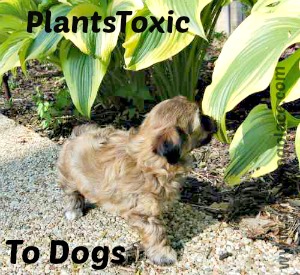 Plants Poisonous to Dogs
Plants Poisonous to DogsWe
have compiled an alphabetized list of many common household plants as
well as outdoor greenery that can cause havoc with your dog if he
decides to ingest them.
Signs of toxicity can range from mild,
to severe, to even fatal, so before you shop for that lovely greenery
that makes a house a home, consider the list below.
At the end of this
list of plants toxic to dogs, you will find several links to sites with
additional information on plants poisonous to dogs.
Plants Toxic To Dogs
Aloe Plant
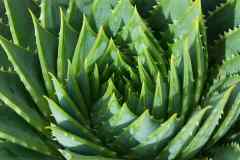 Aloe Vera
Aloe VeraScientific Name: Aloe barbadensis miller.
Other Names: Chinese Aloe, Indian Aloe, True Aloe, Barbados Aloe, Burn Aloe, First Aid Plant
The Aloe plant that many people keep to use as a remedy for burns is one of those common plants toxic to dogs. It grows wild in tropical climates but in cooler climates, it is considered a houseplant.
It that contains a bitter yellow substance which causes vomiting, depression, and diarrhea.
Other symptoms include loss of appetite, tremors, and change in urine color.
American Holly
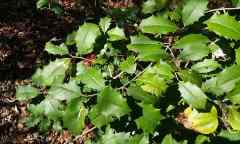 American Holly
American HollyOther Names: English Holly, European Holly, Oregon Holly, Inkberry, Winterberry
Scientific Name: Ilex opaca
This plant grows outdoors, but is also a popular holiday houseplant. It contains the toxic saponins which can cause severe gastrointestinal upset in the form of vomiting and diarrhea.
If your dog ingests this plant, he’s likely to droll, shake his head, and smack his lips due to the injury he’s likely to sustain from chomping on the spiny leaves.
Amaryllis
 Amaryllis
AmaryllisOther Names: Belladonna lily, Saint Joseph lily, Cape Belladonna, Naked Lady
Scientific Name: Amaryllis sp.
This lovely garden plant is also very popular around Christmas, but toxic to cats and dogs.
The bulb is the most toxic, so once the flowers finish for the holiday, do not leave the bulb where your dog could get it.
Amaryllis plants are poisonous to dogs because of the lycorine, a serious toxin to many animals and humans.
Symptoms of a toxic reaction include vomiting, depression, diarrhea, abdominal pain, hyper-salivation, anorexia, and tremors.
Asparagus Fern
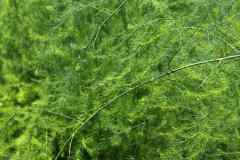 Asparagus Fern
Asparagus FernOther Common Names: Asparagus, Emerald Feather, Emerald Fern, Sprengeri Fern, Plumosa Fern, Lace Fern, Racemose Asparagus, Shatavari
Scientific Name: Asparagus densiflorus cv sprengeri
The asparagus fern is a common plant found indoors and in warmer climates grows outdoors.
It is toxic to both dogs and cats if they ingest the berries of the plant.
Vomiting, diarrhea and/or abdominal pain can result. Allergic dermatitis or skin inflammation can occur if an animal is exposed repeatedly.
Autumn Crocus
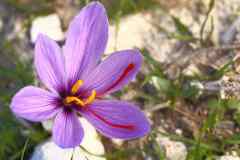 Autumn Crocus
Autumn CrocusOther Names: Meadow Saffron
Scientific Name: Colchicum autumnale
There are two common crocus plants, the familiar early spring bloomer, a member of the iris family, and the autumn crocus part of the lily family.
The spring crocus rarely causes symptoms more serious than vomiting and diarrhea in dogs.
The autumn crocus contains colchicine, a highly poisonous alkaloid. Ingestion of any part of this plant can cause severe, bloody vomiting and diarrhea, bone marrow damage, shock, kidney and liver damage and respiratory failure.
If unsure of the plant species, immediately take the dog for medical attention.
Initial symptoms may be slight or delayed for days.
Azalea / Rhododendron
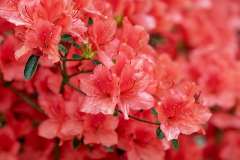 Azalea / Rhododendron
Azalea / RhododendronOther Names: Rosebay, Rhododendron
Scientific Name: Rhododendron spp
This popular garden plant is not only toxic to dogs, but also dangerous for cats, horses, goats and sheep–and ingestion of just a few leaves can cause serious problems.
Members of the Rhododendron family contain substances known as grayantoxins, which are responsible for all the symptoms.
Among the more common plants toxic to dogs, symptoms that you might notice include digestive upset, excessive drooling, loss of appetite, diarrhea, colic, depression, weakness, loss of coordination, stupor, leg paralysis and weak heart rate.
The dog may become comatose and die.
Baby’s Breath
 Baby’s Breath
Baby’s BreathOther Names: Maiden’s Breath
Scientific Name: Gypsophila elegans
This sweet white filler of many a floral arrangement seems innocent enough, but not so innocuous when it comes to your pet’s digestion.
Dogs that tend to eat indoor arrangements can come in contact with this plant which causes vomiting and diarrhea.
More of a problem in cats, we’ve included this in our plants toxic to dogs list because some dogs love to investigate fresh flower arrangements.
Begonia
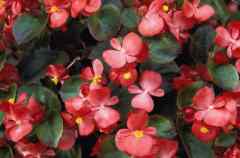 Begonia
BegoniaOther Names: Thousands of different hybrids of this plant
Scientific Name: Begonia spp.
This popular garden and container plant is toxic to both dogs and cats.
The tubers or root areas are the most toxic part.
Symptoms of poisoning include oral burning and irritation to the mouth, tongue and lips, vomiting, and difficulty swallowing.
The dog is likely to be drooling as well.
Buttercup
 Buttercup
ButtercupOther Names: Butter Cress, Figwort
Scientific Name: Ranunculus sp.
This dainty yellow flower isn’t particularly popular in home gardening, but the buttercup is a prolific weed that thrives in less than ideal conditions. You and your pup are likely to encounter some if you spend any time outdoors.
Symptoms include drooling, vomiting, diarrhea, weakness, tremors, seizures or the appearance of blisters in the mouth, signaling that your pup may have eaten too much buttercup.
Fortunately, buttercups have an extremely bitter taste that often causes a dog to stop chewing long before he’s eaten enough to cause damage.
Castor Bean
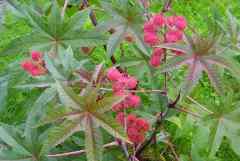 Castor Bean
Castor BeanOther Names: Castor Oil Plant, Mole Bean Plant, African Wonder Tree,
Scientific Name: Ricinus communis
A fast growing plant that can be found along paths and wooded areas, the beans are highly toxic.
If ingested they cause oral irritation, burning, increased thirst, vomiting, diarrhea, kidney failure, and convulsions and death.
As little as one ounce of seeds can be fatal.
Considered an invasive plant by many,this is not one of those plants you want growing in your yard.
Chrysanthemum
 Chrysanthemum
ChrysanthemumOther Names: Daisy, Mum;
Scientific Name: Chrysanthemum spp.
Dogs and cats may still be drawn to this lovely fall flowering plant. It’s not likely to cause death, but it is a popular plant and can cause quite a bit of discomfort.
In certain cases, depression and loss of coordination may also develop if enough of any part of the plant is consumed.
The most common symptoms include vomiting, diarrhea, dermatitis, and excessive salivating.
Cyclamen
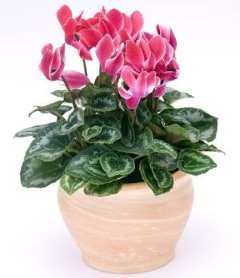 Cyclamen
CyclamenOther Names: Sowbread
Scientific Name: Cycamen spp.
Cyclamen or Sowbread is a beautiful flowering plant that is toxic to dogs and cats.
Grown indoors as a house plant or outside as a garden plant, the roots of these plants can be deadly.
If ingested, this plant can cause increased salivation, vomiting and diarrhea.
If an animal ingests a large amount of the plant’s tubers below the soil, they can suffer heart rhythm abnormalities, seizures and even death.
Daffodil
 Daffodil
DaffodilOther Names: Narcissus, Jonquil, Paper White
Scientific Name: Narcissus spp
I can’t image a dog eating these but puppies are attracted to these pretty flowers that remind us that spring is here.
The flowers contain lycorine which is a substance that can trigger vomiting.
The bulbs are the most dangerous.
Ingesting the bulbs will cause vomiting, salivation, and diarrhea.
If the dog ingests enough, it can cause convulsions, low blood pressure, tremors and heart arrhythmia.
Dieffenbachia
 Dieffenbachia
DieffenbachiaOther Names: Giant Dumb Cane, Dumbcane, Exotica, Spotted Dumb Cane,
Scientific Name: Dieffenbachia spp.
Dieffenbachia which is commonly called, Dumb Cane, Tropic Snow or Exotica is toxic to dogs and cats if ingested or even tasted.
If the plant is ingested, oral irritation can occur, especially on the tongue and lips.
This irritation can lead to increased salivation, vomiting and difficulty swallowing.
Elephant Ear
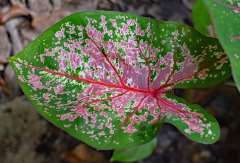 Elephant Ear
Elephant EarOther Names: Caladium, Taro, Pai, Ape, Cape, Via, Via sori, Malanga
Scientific Name: Caladium hortulanum
Elephant ear also called Caladium, contains a chemical similar to that in dieffenbachia.
The toxic reaction to elephant ear is similar and includes oral irritation to the tongue and lips, increased salivation, and difficulty swallowing and vomiting.
English Holly
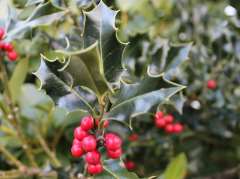 English Holly
English HollyOther Names: American Holly, European Holly, Oregon Holly, Inkberry, Winterberry
Scientific Name: Llex opaca
The red berries may be attractive to your dog and they are poisonous, but so is the bark, leaves and seeds.
The poison found in holly is theobromine, an alkaloid similar to caffeine.
This toxin is also found in chocolate, another food that dogs should not eat.
Ingesting this plant can cause diarrhea, vomiting and depression.
Gladiola
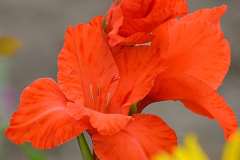 Gladiola
GladiolaScientific Name: Gladiolus species
Many people grow these in the garden and they also make a popular choice in floral arrangements.
The bulb is the most toxic to dogs and if eaten will cause salivation, vomiting, drooling, lethargy and diarrhea.
The moral of the story: Don’t let your dog help you plant those bulbs!
Hibiscus
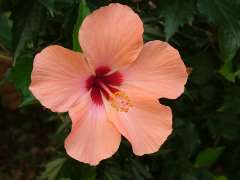 Hibiscus
HibiscusOther Names: Rose of Sharon, Rose of China
Scientific Name: Hibiscus syriacus
Also known as the Rose of Sharon, this lovely flower is on our list of plants toxic to dogs.
The toxic principles are unknown, but if ingested, the dog can experience gastrointestinal symptoms such as loss of appetite, nausea, vomiting and diarrhea.
If symptoms are severe, dehydration can occur and you should take your dog to the veterinarian for treatment.
Hosta
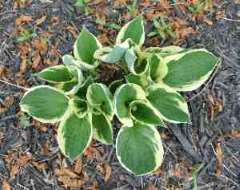 Hosta
HostaOther Names: Plantain Lily, Funkia
Scientific Name: Hosta plantaginea
These plants are very common and make a perfect addition to a shaded garden.
Most dogs do not bother these plants, but if yours is an exception, it is toxic and can cause vomiting, diarrhea and depression.
Hyacinth
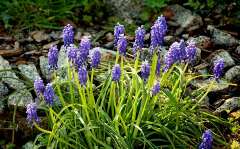 Hyacinth
HyacinthScientific Name: Hyacinthus orientalis
This lovely spring flower is not highly toxic to dogs, although ingesting them can lead to oral and esophageal tissue inflammation.
Depending on the amount a dog consumes, symptoms can include profuse drooling, vomiting and diarrhea. There is no known antidote. The highest toxicity is concentrated in the bulbs, which dogs obtain by digging in the yard or raiding a bulb awaiting planting.
When a dog eats a large amount of a bulb, she may experience serious changes in heart rate and respiration, which need the immediate attention of a veterinarian.
Hydrangea
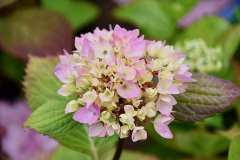 Hydrangea
HydrangeaOther Names: Hortensia, Hills of Snow, Seven Bark
Scientific Name: Hydrangea arborescens
These beautiful flowers grow on a bush and change color depending on the type of soil they are grown in.
While beautiful to look at, your dog should not try to nibble on the plant.
They aren’t one of the more toxic plants, but can cause gastrointestinal upset including diarrhea, vomiting, and lethargy.
If this plant grows in your garden, just keep an eye on your dog.
Ivy
 Ivy
IvyOther Names: Branching Ivy, Glacier Ivy, Needlepoint Ivy, Sweetheart Ivy, California Ivy
Scientific Names: Hedera helix
Many members of the Ivy family are toxic including California Ivy, Branching Ivy, Glacier Ivy, Needlepoint Ivy, Sweetheart Ivy, English Ivy are plants toxic to dogs.
The foliage is more toxic than the berries and can produce vomiting, abdominal pain, excessive salivation and diarrhea
Jade Plant
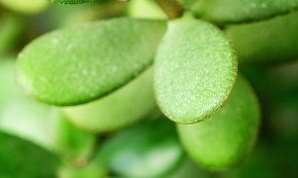 Jade Plant
Jade PlantOther Names: Baby Jade, Dwarf rubber plant, Jade tree, Chinese rubber plant, Japanese rubber plant
Scientific Name: Crassula argentea
Jade plants are toxic to dogs and cats. Other names for this plant include Baby jade, Dwarf Rubber plant, Jade tree, Chinese rubber plant, Japanese rubber plant or Friendship tree.
Ingesting these plants can cause depression, ataxia (incoordination) and bradycardia or slow heart rate but this is rare.
Lily of the Valley
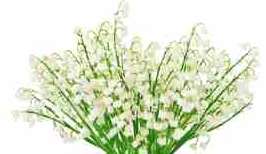 Lily of the Valley
Lily of the ValleyScientific Name: Convallaria majalis
The small, fragrant lily of the valley is often used as a border plant.Despite its innocent appearance, this plant can have deadly consequences for a dog.
This plant contains cardiac glycosides which will cause symptoms similar to digitalis ingestion.These are the compounds that cause serious cardiac arrhythmias, vomiting, and diarrhea, a drop in heart rate and possibly seizures and coma.
Oleander
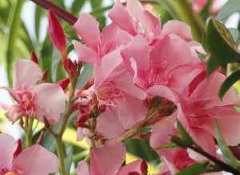 Oleander
OleanderOther Names: Rose-Bay
Scientific Name: Nerium oleander
Oleander can be seen lining the highway is some southern cities and a very common garden plant in warmer climates.
It is toxic to cats, dogs, and even horses. Listed as one of the plants toxic to dogs, it is also considered more dangerous than some.
All parts contain a highly toxic cardiac glycoside similar to digitoxin and can cause a number of problems.
Symptoms include colic, diarrhea, often with blood, sweating, in coordination, shallow/difficult breathing, muscle tremors, and possibly death from cardiac failure.
Philodendron
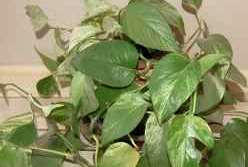 Philodendron
PhilodendronScientific Name: Philodendron spp
Philodendron is a common, easy-to-grow houseplant that is toxic to dogs and cats.
It contains a chemical that can irritate the mouth, tongue and lips of animals.
An affected pet may also experience increased salivation, vomiting and difficulty swallowing.
Poinsettia
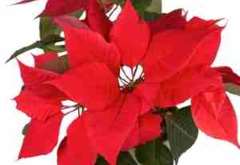 Poinsettia
PoinsettiaScientific Name: Euphorbia pulcherrima
Many people cannot face the holidays with fresh poinsettia.
This ubiquitous holiday decoration may cause discomfort, but not the alarming panic many of us grew up hearing.
Symptoms if ingested can be irritation to the mouth and stomach and occasional vomiting.
Pothos
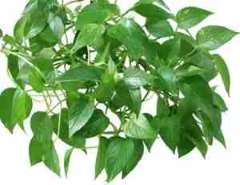 Pothos
PothosOther Names: Golden Pothos, Devil’s Ivy, Taro Vine, Ivy Arum
Scientific Name: Epipremnum aureum
Satin pothos or silk pothos is one of those plants toxic to dogs if ingested and will irritate the mouth, lips and tongue.
The dog may also show signs of increased salivation, vomiting and/or difficulty swallowing.This is due to irritation and swelling of the oral tissues and other parts of the gastrointestinal tract.
Sago Palm
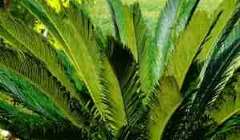 Sago Palm
Sago PalmOther Names: Coontie Palm, Cardboard Palm, cycads and zamias
Scientific Name: Cycas revoluta
Very popular in warmer climates, they make great landscaping plants. They also grow indoors in containers.
Sago Palm – All parts of the plant are poisonous, but the seeds or “nuts” contain the largest amount of toxin.
The ingestion of just one or two seeds can result in very serious effects, which include vomiting, diarrhea, depression, seizures and liver failure.
Tomato Plant
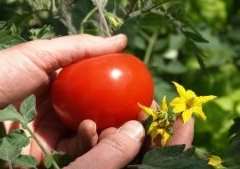 Tomato Plant
Tomato PlantScientific Name: Lycopersicon spp
Although tomato plants probably won’t prove lethal for your pet, they can provide a good amount of discomfort.
The plants, leaves, stems are the problems, not the fruit. Stems and leaves can produce increased salivation, gastric upset, diarrhea, drowsiness, Central Nervous System depression, confusion, weakness, dilated pupils and slow heart rate.
So don’t panic if your dog enjoys tomatoes as much as you.
It is the foliage that is listed as plants toxic to dogs.
Tulip or Narcissus
 Tulip or Narcissus
Tulip or NarcissusScientific Name: Tulipa species
It’s the bulb of the tulip and narcissus plants that have the highest concentration of toxins.This means: if you have a dog that digs, be cautious.
Or, if you are forcing bulbs indoors, make sure they are out of reach. Symptoms can include drooling, loss of appetite, depression of the central nervous systems, convulsions and cardiac abnormalities. As a general rule of thumb, keep all bulbs away from your dog.
Yew
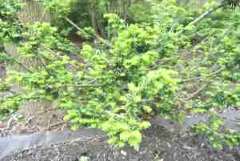 Japanese yew
Japanese yewOther Names: Japanese yew
Scientific Name: Taxus sp.
The Yew completes our list of plants toxic to dogs because it contains a compound known as taxine.
This causes CNS effects such as trembling, poor coordination, and difficulty breathing.
It can also cause significant gastrointestinal irritation and cardiac failure, which can result in death. This is definitely a plant that dogs should avoid.
This is only a small list of plants toxic to dogs. For more information, the ASPCA website offers a much more comprehensive list.
If you think your dog has eaten something he should not have, call your veterinarian.
Two poison control organizations that are helpful and are available to you 24/7 are the Animal Poison Control Center (1-888-426-4435) and the Pet Poison Helpline (1-800-213-6680).
Does This Article Deserve Your Thumbs Up?
We always appreciate your support and encouragement. Your thumbs up means so much to us. Please like this article.
If you find this page or any page on Small Dog Place Helpful, or Useful in anyway, I’d love it if you would click the small heart found on the bottom right of each page.
You can also share or bookmark this page — just click on the:

Free Monthly Newsletter
Sign Up for Our Free Newsletter and get our Free Gift to You.
my E-book, The Top 10 Mistakes People Make When Choosing a Dog (and how to avoid them)




